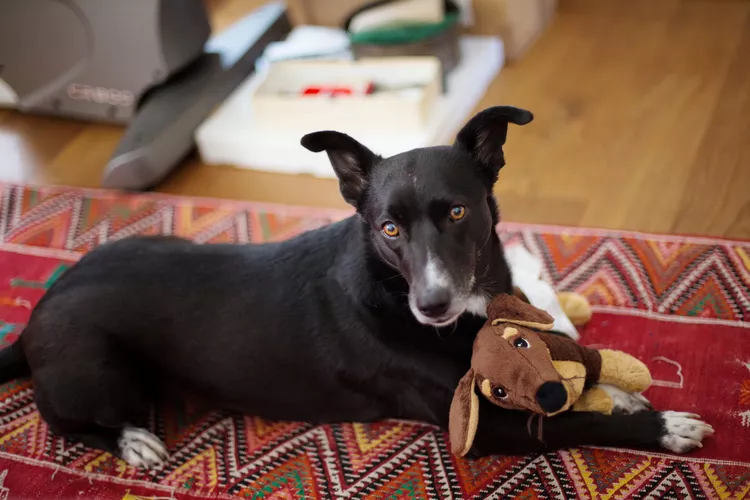Dog Heat Cycle: Length, Frequency, and Stages

A dog's heat cycle happens in about five to seven months, and a typical heat period with bleeding will last two to four weeks. There are four phases to the heat cycle, each with its own signs and behaviors. Bleeding or bloody discharge occurs in two of the four phases. You may need to take steps to keep their discharge from getting on the furniture or to handle an issue like a uterine infection. Here's what to expect before, during, and after your dog's heat cycle.
What Is a Dog's Heat Cycle?
A dog's heat cycle, called estrous, refers to the time when a dog is fertile and ready to mate.
Four Stages of the Canine Heat Cycle
During your dog’s complete heat cycle, or estrous, she will experience four phases. A typical heat period lasts roughly two to four weeks, with a pregnancy or resting phase following the estrus period. Most dogs have about two heat cycles per year.
Knowing what to expect will help prepare you and your dog for any abnormal behaviors or problems during her heat cycle. As your pooch progresses through her cycle, you will notice these four stages:
Proestrus
Proestrus is the start of the heat period where your dog’s body is preparing to mate and averages about nine days, but can last from three to 17 days. Her vulva will swell and you may notice a blood-tinged discharge, but many dogs are fastidious about messes and will clean themselves before you notice. Your dog may also hold her tail close to her body and stick just as close to your side, displaying clingy behavior. At this stage of the heat cycle, your dog will attract males, but she will not be receptive to them and may become aggressive if they try to mount her.
Estrus
The estrus phase is the mating phase and usually lasts around nine days, but can be as short as three or as long as 21 days. During this time, blood flow will lessen and then stop, but the discharge may change to a straw color. Female dogs will attract and accept males, with ovulation occurring two to three days after mating. You may notice your dog urinating more frequently and marking spots within and outside your home to spread pheromone messages indicating her readiness to breed. If an intact male is present, your female dog is likely to present herself to him, hindquarters first, and with her tail held to the side.
Diestrus
The diestrus phase occurs directly after the “in heat” stage and lasts for about two months. Her body will proceed with the pregnancy or return to rest, as her vulva returns to normal size and the vaginal discharge disappears.
Anestrus
Anestrus is the uterine repair phase, in which no sexual or hormonal behavior is present, and can last for anywhere from 90 to 150 days before the next proestrus stage begins.
When Do Dogs Go Into Heat?
The age at which a dog experiences her first estrus varies greatly between breeds. On average, a female dog will come into her first heat between six and 15 months of age. However, toy and small breeds mature much earlier than giant breeds and can come into heat as early as four months of age. Giant breeds might be two years old before they experience their first heat. Heat cycles will repeat around every six months throughout a dog's life; dogs do not go through menopause like humans.
The only option to prevent your dog from going into heat is to have her spayed. Spaying is highly recommended for all female dogs unless you plan on strengthening the breed through responsible breeding. Once your dog is spayed, she will have a reduced risk for mammary cancer and will be unable to contract uterine infections (pyometra) or go through a heat cycle.
Most veterinarians recommend spaying a dog before her first or second heat cycle. You can have your dog spayed while she is going through her heat, but the surgery is more complex. Speak with your veterinarian about the best time to spay your dog.
Warning
To prevent an unwanted pregnancy while your dog is in heat, keep her separated from male dogs for at least three to four weeks after the first sign of bleeding. And just because your dog is no longer bleeding, does not mean she can no longer get pregnant. She’s much more likely to let a male mate immediately after the bloody discharge stops.
How to Care for a Dog in Heat
Your dog shouldn't need much help while she is in heat, but there are a few things to keep in mind:
- If your dog is spotting or bleeding on furniture or floors, you can put special diapers or clothing on her to catch the discharge.
- Dogs in heat typically urinate more frequently, so give your dog extra potty breaks during this time.
- You may notice personality changes, agitation, or anxiety while your dog is in heat. Provide extra playtime, exercise, and puzzle toys to help keep them busy.
- Although dogs can get pregnant during their first heat cycle, this is not recommended because a six-month-old dog is not yet fully grown or mature, and complications for the mother and the puppies are more likely.
- Males may be attracted to your female before she is receptive to mating, so protect her from other dogs while on walks or in the yard.
- Your female in heat will have a drive to mate and may try to escape to find a male. Use caution during this time to prevent an unwanted pregnancy. Your dog should remain indoors while you're gone and supervised while in fenced-in yards. Keep your dog on a leash during walks and avoid intact males.